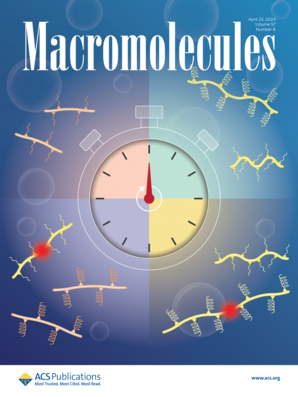外部电位诱导的捕获聚合物中单体迁移率的增强:一个广义朗之万方程研究
IF 5.2
1区 化学
Q1 POLYMER SCIENCE
引用次数: 0
摘要
在被捕获的聚合物中,单体摩擦是控制物理、化学和生物学中广泛的动态和动力学过程的基本时间尺度的关键决定因素。在本文中,我们提出了一个理论研究的单个劳斯链被困在一个谐波电位单体摩擦。我们的分析是基于广义朗之万方程(GLE)框架内的摩擦记忆函数。摩擦记忆功能包括溶剂摩擦(假设是恒定的,独立于外部电位)和链内摩擦的贡献。我们证明了外部电位通过改变单体间的相关关系诱导出一个附加的谐波电位。这种修改反过来又改变了摩擦记忆功能。我们对诱导电位和弛豫时间谱的分析揭示了一个特征链长Nc,它描述了谐波约束链的无扰动大小。在长链极限(链长N∶Nc∶1)下,随时间变化的单体摩擦函数在中时间尺度上表现出普遍的幂律行为。具体来说,指数随着k ‘ /k(其中k ’为外谐波电位强度,k为键弹簧强度)的增加而从1/2减小到0。这种行为与动态缩放参数一致。在较长时间内,摩擦函数达到平稳状态,其值从k′/k≪1时的Ncγ/2到k′/k≠1时的溶剂摩擦γ不等。这些结果表明,外电位通过减少链内摩擦来促进单体扩散。这一发现提供了对捕获聚合物动力学的基本理解,并强调了外部电位在改变链内相互作用和单体迁移率方面的关键作用。本文章由计算机程序翻译,如有差异,请以英文原文为准。

External Potential-Induced Enhancement of Monomer Mobility in Trapped Polymers: A Generalized Langevin Equation Study
Monomer friction in trapped polymers is a key determinant of the fundamental time scales governing a wide range of dynamic and kinetic processes in physics, chemistry, and biology. In this paper, we present a theoretical investigation of the monomer friction of individual Rouse chains trapped in a harmonic potential. Our analysis is based on the friction memory function within the framework of the generalized Langevin equation (GLE). The friction memory function comprises contributions from both solvent friction (assumed to be constant and independent of the external potential) and intra-chain friction. We demonstrate that the external potential induces an additional harmonic potential by modifying the correlations between monomers. This modification, in turn, alters the friction memory function. Our analyses of the induced potentials and relaxation time spectra reveal a characteristic chain length Nc, which describes the unperturbed size of the harmonically confined chain. In the long chain limit (chain length N ≫ Nc ≫ 1), the time-dependent monomer friction function exhibits universal power-law behaviors in the mediate time scale. Specifically, the exponent decreases from 1/2 to 0 as the ratio k′/k (where k′ is the external harmonic potential strength and k is the bond spring strength) increases. This behavior aligns with dynamic scaling arguments. In the long time limit, the friction function reaches a plateau, with the value varying from Ncγ/2 for k′/k ≪ 1 to the solvent friction γ for k′/k ≫ 1. These results indicate that the external potential enhances monomer diffusion by reducing intra-chain friction. This finding provides a fundamental understanding of the dynamics of trapped polymers and highlights the crucial role of external potentials in modifying intra-chain interactions and monomer mobility.
求助全文
通过发布文献求助,成功后即可免费获取论文全文。
去求助
来源期刊

Macromolecules
工程技术-高分子科学
CiteScore
9.30
自引率
16.40%
发文量
942
审稿时长
2 months
期刊介绍:
Macromolecules publishes original, fundamental, and impactful research on all aspects of polymer science. Topics of interest include synthesis (e.g., controlled polymerizations, polymerization catalysis, post polymerization modification, new monomer structures and polymer architectures, and polymerization mechanisms/kinetics analysis); phase behavior, thermodynamics, dynamic, and ordering/disordering phenomena (e.g., self-assembly, gelation, crystallization, solution/melt/solid-state characteristics); structure and properties (e.g., mechanical and rheological properties, surface/interfacial characteristics, electronic and transport properties); new state of the art characterization (e.g., spectroscopy, scattering, microscopy, rheology), simulation (e.g., Monte Carlo, molecular dynamics, multi-scale/coarse-grained modeling), and theoretical methods. Renewable/sustainable polymers, polymer networks, responsive polymers, electro-, magneto- and opto-active macromolecules, inorganic polymers, charge-transporting polymers (ion-containing, semiconducting, and conducting), nanostructured polymers, and polymer composites are also of interest. Typical papers published in Macromolecules showcase important and innovative concepts, experimental methods/observations, and theoretical/computational approaches that demonstrate a fundamental advance in the understanding of polymers.
 求助内容:
求助内容: 应助结果提醒方式:
应助结果提醒方式:


